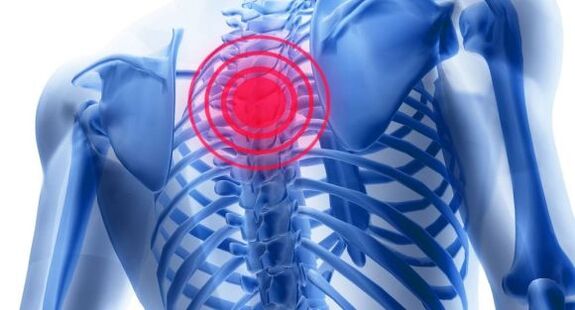
Thoracic osteochondrosis- This is a dystrophic change in the intervertebral discs located in the chest.Treatment of the disease is required to start immediately after diagnosis, as the disease can quickly go into chronic form.
The main symptoms of the disease are the limitation of the mobility of the shoulder girdle, shortness of breath, discomfort in the stomach and chest pain that are distributed in the heart.The risk for the patient is that the symptoms of osteochondrosis are often confused with cardiovascular disease, therefore therapy is performed by the wrong disease.
The causes of osteochondrosis
Thoracic osteochondrosis occurs as a result of pathological changes in the vertebrae and intervertebral discs, as well as impaired blood supply and nutrition.In addition, the disease can be caused by deformity of the spine.
Especially often, people who are in a sedentary position suffer from the symptoms of breast osteochondrosis.In general, these are office workers and students of different ages.Due to constant sitting, without monitoring the proper position of the body, the load of the vertebrae increases significantly, which causes their deformity.
The main causes of the disease:
- increased spinal load that occurs when weight lifting
- Changes in the age in the body
- overweight
- Spinal cord injuries
- genetic level predisposition
Depending on the stage of symptoms, it is divided into 2 clinical cases.In the first case, the pain occurs suddenly and has an acute form (the so -called "lateral").In the second case, the pain is long and is often accompanied by stiffness in the cervix and chest.Breast osteochondrosis pain limits back mobility and also causes difficulty breathing.
The treatment of osteochondrosis of the chest area is performed using complex methods and schemes, the compilation of which depends on the stage of the disease, its course and causes.Only a highly qualified specialist is able to handle this task.
Stages of the disease
The first stageIt is characterized by the appearance of local pain due to weakening of the muscles (thoracalgia).In addition, in the first stage there is a tension of the paravertebral muscles of the back, which leads to increased pain and limitation of the mobility of the spine.
The second stageIt is accompanied by an increase in pain syndrome, as nerve roots are involved in the inflammatory process.Also at this stage there are convexity and/or hernia of intervertebral discs (MPD).
The third stageIt causes constant pain that occurs in the area of the affected nerve.There is a change in gait, numbness in the limbs, the onset of headache, difficulty breathing and damage to the heart rate.This is due to the manifestation of significant deformities of the intervertebral disc and spine.The risk of sequestion increases sharply (sequestion is the division of hernia and its movement on the spine, which injures the nerve roots associated with the spinal cord).And this in 90% of cases leads to surgery.
ToFourth stageDiseases impair the functions of the intervertebral disc.The bone growth of the vertebrae bodies begins to connect close to each other.Osteochondrosis of the spine often causes a disorder of the blood supply to the spinal cord.This stage of the disease is the most dangerous because without timely therapy leads to damage.
Treatment
Before proceeding with treatment, a diagnosis is made to detect the stage of the disease (initially, acute or chronic).Depending on the existing symptoms, methods of therapy are selected.
The treatment of osteochondrosis of the thoracic region is most effective in the initial stages, when pathological changes are not so clearly expressed and reversible.
The main sign that the disease has gone to the acute stage is constantly painful sensations in;Muscles on the back, chest and spine.At this stage of the development of osteochondrosis, the priority task of the doctor is to relieve pain.













































